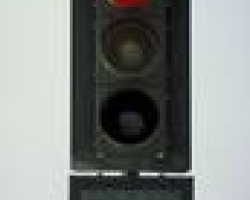
Motorists traveling through Culver City can expect to see red light cameras at heavily traveled intersections in Culver City, but not always at the same location.
Two red lights cameras at intersections with a relatively high volume of traffic are not operational and another has been recently removed, the News has learned.
Devices at the intersections of Sepulveda Boulevard and Machado Road have been disabled, as was one at Jefferson Boulevard and Cota Avenue near the Studio Village Shopping Center.
“Those approaches have been relocated,” confirmed Sgt. Omar Corrales, who is in charge of the department’s traffic bureau. “We’re consistently monitoring and evaluating our program and where it will work the best.
“If we can minimize collisions and running red lights, that’s what we want.”
Corrales said that from time to time, the department relocates the cameras to different locations, depending on the volume of traffic incidents at a particular intersection.
The camera at Washington Boulevard and Centinela Avenue has also been moved, the sergeant said.
Despite the decision of the Los Angeles City Council to dissolve its red light photo camera program last month, Culver City police officials feel that theirs has been a success and stand by the traffic enforcement initiative.
“Our system is doing exactly what we expect it to do,” Corrales said.
There are 20 red light enforcement cameras, or approaches, at 12 intersections throughout Culver City.
According to the Insurance Institute for Highway Safety, 22% of all traffic accidents in the United States are caused by drivers running red lights. Every year, these accidents kill some 800 people and rack up an estimated $7 billion in property damage, medical bills, lost productivity and insurance hikes.
In many areas, red light violations have increased by 10% or more since the 1980s, according to the institute.
Culver City implemented its photo ticket initiative in 1999 and it became fully operational in 2000.
The devices are used worldwide and while law enforcement authorities cite public safety as the primary reason that the cameras have been installed, opponents of the cameras claim they are used primarily to pad the government’s coffers.
Corrales said the incidents of running red lights have decreased at Sepulveda and Machado, as well as at Jefferson and Cota since the cameras were installed.
One of the red light camera locations, at Washington and Helms Avenue in east Culver City is at the center of a legal action filed against the city. Motorist Stephen Gray was photographed by a red light camera running the stoplight at that intersection of on Nov. 21, 2008. His attorney, Sherman Ellison of Sherman Oaks, says Section 21455.5 (b) of the state Vehicle Code states that cities are required to give a 30-day notice of where all red light cameras will be installed, along with its location, prior to issuing any citation.
Gray was found guilty of the infraction in Santa Monica Municipal Court and appealed the verdict to a state appellate court. A ruling in People vs. Stephen Gray is pending.
According to the Culver City Police Department’s website, the city’s yellow phases are in compliance with the traffic manual, so at an intersection with a speed limit of 35 mph, the yellow phase is 3.6 seconds; at an intersection with a speed limit of 40 mph, the yellow phase is 3.9 seconds and at 45 mph, the yellow phase is 4.3 seconds.
Ellison, who has won reversals of traffic cases in appellate and federal court, said minor adjustments could make a big difference in reducing tickets and accidents at red light camera intersections. “If the time between the changes between the red and yellow lights were adjusted by one second, that would solve a lot of problems,” he said. “If Culver City wanted to increase safety of the motoring public, they simply need to lengthen the delay between cross traffic.”
Robert Zirgulis, a Culver City resident who made disbanding red light cameras the centerpiece of his campaign for city council last year, also thinks a change in the timing of the lights would be an improvement for motorists.
“A better policy would be to change the timing on the lights changing from yellow to red,” he said. “A longer yellow light allows traffic to clear the intersection.”
Zirgulis, who is a candidate in the Culver City Unified School District Board of Education’s election, said he was unaware that some of the cameras had been relocated. “I’ve seen the same ones for years,” he said.
Corrales said there were several reasons why the signs that advise motorists of photo enforcement at the abovementioned intersections remain there. “One is that they can act as a deterrent, much like parking a black-and-white police unit in front of a school or in a visible place of a large shopping mall,” the sergeant explained. “Also, by keeping them at the location, people think that there’s still a functioning camera.”
Another reason is expediency and convenience. “If we decide that we need to reactivate the cameras again, the infrastructure is already in place,” Corrales said.
Washington and Sawtelle boulevards and Sepulveda and Slauson Avenue are new locations where red light photo cameras have been installed.
Nearly 30 California cities have decided in recent years to drop their red light camera enforcement programs.
Beverly Hills and Santa Clarita recently stated that they will continue with their programs.
